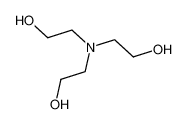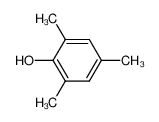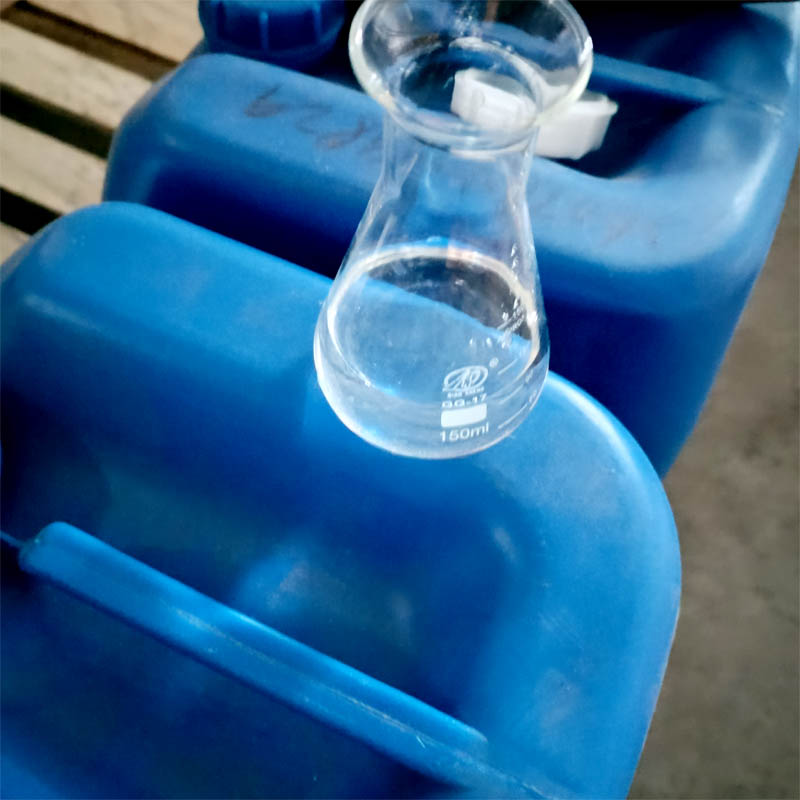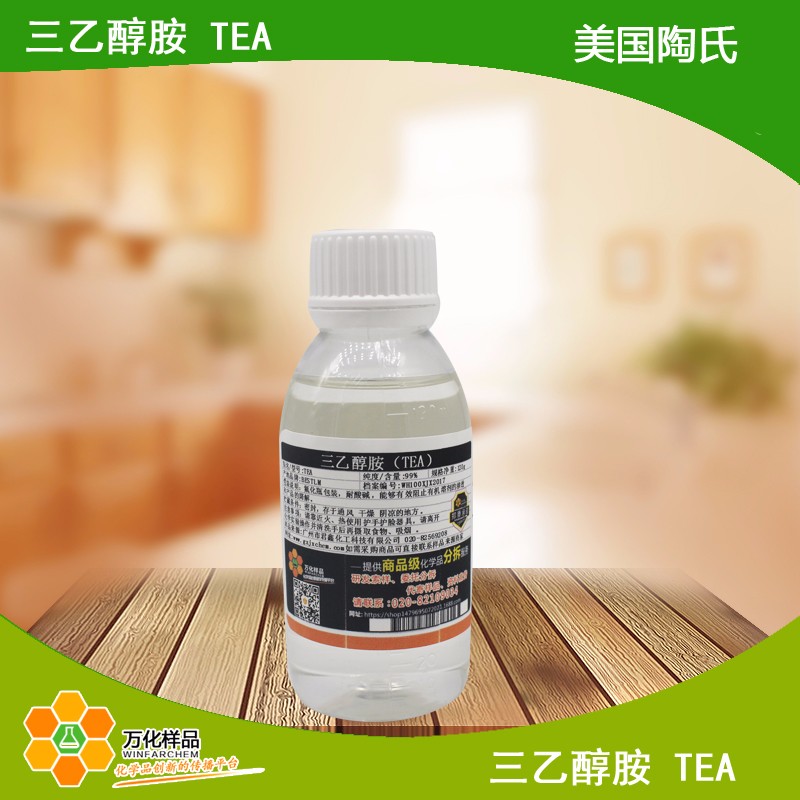1.Identification
1.1 GHS Product identifier
| Product name | Triethanolamine |
|---|
1.2 Other means of identification
| Product number | - |
|---|---|
| Other names | 2,2',2''-Nitrilotriethanol |
1.3 Recommended use of the chemical and restrictions on use
| Identified uses | For industry use only. Specialized Industrial Chemicals |
|---|---|
| Uses advised against | no data available |
1.4 Supplier's details
| Company | MOLBASE (Shanghai) Biotechnology Co., Ltd. |
|---|---|
| Address | Floor 4 & 5, Building 12, No. 1001 North Qinzhou Road, Xuhui District, Shanghai, China |
| Telephone | +86(21)64956998 |
| Fax | +86(21)54365166 |
1.5 Emergency phone number
| Emergency phone number | +86-400-6021-666 |
|---|---|
| Service hours | Monday to Friday, 9am-5pm (Standard time zone: UTC/GMT +8 hours). |
2.Hazard identification
2.1 Classification of the substance or mixture
Not classified.
2.2 GHS label elements, including precautionary statements
| Pictogram(s) | No symbol. |
|---|---|
| Signal word | No signal word. |
| Hazard statement(s) | none |
| Precautionary statement(s) | |
| Prevention | none |
| Response | none |
| Storage | none |
| Disposal | none |
2.3 Other hazards which do not result in classification
none
3.Composition/information on ingredients
3.1 Substances
| Chemical name | Common names and synonyms | CAS number | EC number | Concentration |
|---|---|---|---|---|
| Triethanolamine | Triethanolamine | 102-71-6 | none | 100% |
4.First-aid measures
4.1 Description of necessary first-aid measures
General advice
Consult a physician. Show this safety data sheet to the doctor in attendance.
If inhaled
Fresh air, rest.
In case of skin contact
Remove contaminated clothes. Rinse and then wash skin with water and soap.
In case of eye contact
First rinse with plenty of water for several minutes (remove contact lenses if easily possible), then refer for medical attention.
If swallowed
Give one or two glasses of water to drink.
4.2 Most important symptoms/effects, acute and delayed
Liquid may irritate eyes and skin. (USCG, 1999)
4.3 Indication of immediate medical attention and special treatment needed, if necessary
/SRP:/ Immediate first aid: Ensure that adequate decontamination has been carried out. If patient is not breathing, start artificial respiration, preferably with a demand-valve resuscitator, bag-valve-mask device, or pocket mask, as trained. Perform CPR as necessary. Immediately flush contaminated eyes with gently flowing water. Do not induce vomiting. If vomiting occurs, lean patient forward or place on left side (head-down position, if possible) to maintain an open airway and prevent aspiration. Keep patient quiet and maintain normal body temperature. Obtain medical attention. /Organic bases/amines and related compounds/
5.Fire-fighting measures
5.1 Extinguishing media
Suitable extinguishing media
Suitable extinguishing media: Use water spray, alcohol-resistant foam, dry chemical, or carbon dioxide.
5.2 Specific hazards arising from the chemical
Special Hazards of Combustion Products: Poisonous gases, such as NOx, may be produced (USCG, 1999)
5.3 Special protective actions for fire-fighters
Wear self-contained breathing apparatus for firefighting if necessary.
6.Accidental release measures
6.1 Personal precautions, protective equipment and emergency procedures
Use personal protective equipment. Avoid dust formation. Avoid breathing vapours, mist or gas. Ensure adequate ventilation. Evacuate personnel to safe areas. Avoid breathing dust. For personal protection see section 8.
6.2 Environmental precautions
Collect leaking and spilled liquid in covered containers as far as possible. Then wash away with plenty of water.
6.3 Methods and materials for containment and cleaning up
ACCIDENTAL RELEASE MEASURES: Personal precautions, protective equipment and emergency procedures: Avoid breathing vapors, mist or gas. Environmental precautions: Do not let product enter drains. Methods and materials for containment and cleaning up: Keep in suitable, closed containers for disposal.
7.Handling and storage
7.1 Precautions for safe handling
Avoid contact with skin and eyes. Avoid formation of dust and aerosols. Avoid exposure - obtain special instructions before use.Provide appropriate exhaust ventilation at places where dust is formed. For precautions see section 2.2.
7.2 Conditions for safe storage, including any incompatibilities
Separated from oxidants. Well closed. Dry.Keep container tightly closed in a dry and well-ventilated place. Hygroscopic.
8.Exposure controls/personal protection
8.1 Control parameters
Occupational Exposure limit values
no data available
Biological limit values
no data available
8.2 Appropriate engineering controls
Handle in accordance with good industrial hygiene and safety practice. Wash hands before breaks and at the end of workday.
8.3 Individual protection measures, such as personal protective equipment (PPE)
Eye/face protection
Safety glasses with side-shields conforming to EN166. Use equipment for eye protection tested and approved under appropriate government standards such as NIOSH (US) or EN 166(EU).
Skin protection
Wear impervious clothing. The type of protective equipment must be selected according to the concentration and amount of the dangerous substance at the specific workplace. Handle with gloves. Gloves must be inspected prior to use. Use proper glove removal technique(without touching glove's outer surface) to avoid skin contact with this product. Dispose of contaminated gloves after use in accordance with applicable laws and good laboratory practices. Wash and dry hands. The selected protective gloves have to satisfy the specifications of EU Directive 89/686/EEC and the standard EN 374 derived from it.
Respiratory protection
Wear dust mask when handling large quantities.
Thermal hazards
no data available
9.Physical and chemical properties
| Physical state | Colorless to light yellow, viscous liquid |
|---|---|
| Colour | Viscous liquid |
| Odour | Slight ammonical odor |
| Melting point/ freezing point | 21ºC |
| Boiling point or initial boiling point and boiling range | 190-193°C/5mmHg(lit.) |
| Flammability | Combustible. Gives off irritating or toxic fumes (or gases) in a fire. |
| Lower and upper explosion limit / flammability limit | no data available |
| Flash point | 179°C |
| Auto-ignition temperature | 315.56°C |
| Decomposition temperature | no data available |
| pH | pH = 10.5 (0.1 N aqueous solution); strong base |
| Kinematic viscosity | 590.5 cP at 25°C; 65.7 cP at 60°C |
| Solubility | In water:soluble |
| Partition coefficient n-octanol/water (log value) | log Kow = -1.00 |
| Vapour pressure | 0.01 mm Hg ( 20 °C) |
| Density and/or relative density | 1.124g/mLat 25°C(lit.) |
| Relative vapour density | 5.14 (vs air) |
| Particle characteristics | no data available |
10.Stability and reactivity
10.1 Reactivity
no data available
10.2 Chemical stability
Stable under recommended storage conditions.
10.3 Possibility of hazardous reactions
Fire hazard: Combustible liquid when exposed to heat or flame.TRIETHANOLAMINE is an aminoalcohol. Neutralize acids to form salts plus water in exothermic reactions. Amines may be incompatible with isocyanates, halogenated organics, peroxides, phenols (acidic), epoxides, anhydrides, and acid halides. Flammable gaseous hydrogen is generated in combination with strong reducing agents, such as hydrides. Reacts violently with strong oxidants. [Handling Chemicals Safely 1980. p. 928].
10.4 Conditions to avoid
no data available
10.5 Incompatible materials
Incompatible materials: Acids, oxidizing agents.
10.6 Hazardous decomposition products
Hazardous decomposition products formed under fire conditions - Carbon oxides, nitrogen oxides (NOx).
11.Toxicological information
Acute toxicity
- Oral: LD50 Mice oral 7400 mg/kg
- Inhalation: no data available
- Dermal: no data available
Skin corrosion/irritation
no data available
Serious eye damage/irritation
no data available
Respiratory or skin sensitization
no data available
Germ cell mutagenicity
no data available
Carcinogenicity
Evaluation: There is inadequate evidence in humans for the carcinogenicity of triethanolamine. There is inadequate evidence in experimental animals for the carcinogenicity of triethanolamine. Overall evaluation: Triethanolamine is not classifiable as to its carcinogenicity to humans (Group 3).
Reproductive toxicity
no data available
STOT-single exposure
no data available
STOT-repeated exposure
no data available
Aspiration hazard
no data available
12.Ecological information
12.1 Toxicity
- Toxicity to fish: LC50; Species: Pimephales promelas (fathead minnow); Conditions: flow-through bioassay with measured concentrations, 25.7°C, dissolved oxygen 7.3 g/L, and pH 7.8; Concentration: 11.8 g/L for 96 hr (95% confidence limit 10.6-13.0 g/L)
- Toxicity to daphnia and other aquatic invertebrates: no data available
- Toxicity to algae: EC50; Species: Scenedesmus subspicatus (Green algae); Conditions: tested in the Scenedesmus cell multiplication inhibition test, static; Concentration: 470,000 ug/L for 48 hr; Effect: decreased biomass
- Toxicity to microorganisms: no data available
12.2 Persistence and degradability
AEROBIC: Triethanolamine, present at 50 ppm, was biodegraded 70% ThOD (theoretical oxygen demand) in 10 days in a river die-away test using acclimated Kanawha River water as seed and sewage as inoculum(1). In a BOD test in water using a sewage inoculum, triethanolamine added at an initial concentration 2.5 ppm and run for 5, 10, 15 and 20 days exhibited 0, 0.8, 3.5 and 6.8% ThOD, respectively(2). Another BOD test in water using sewage inoculum incubated for 20 days resulted in 66% ThOD for triethanolamine(3). Using synthetic sea water and sewage inoculum, a 20 day run showed 69% ThOD for triethanolamine(3). Using effluent from a biological sanitary waste treatment plant as an inoculum, triethanolamine degradation was 5% ThOD (unadapted) and 28% ThOD (adapted) in a 5 day test(4). Triethanolamine, present at 500 ppm, added to BOD water with an activated sludge inoculum and acclimated for 15 days resulted in 22% ThOD after a 10 day test period(5).
12.3 Bioaccumulative potential
BCFs of <0.4 and <3.9 were reported using carp (Cyprinus carpio) which were exposed to respective concentrations of 2.5 and 25 ppm of triethanolamine over a 6-week period(1). According to a classification scheme(2), these BCFs suggest bioconcentration in aquatic organisms is low.
12.4 Mobility in soil
Using a structure estimation method based on molecular connectivity indices(1), the Koc of triethanolamine can be estimated to be 10(SRC). According to a classification scheme(2), this estimated Koc value suggests that triethanolamine is expected to have very high mobility in soil. The pKa of triethanolamine is 7.76(3), indicating that this compound will partially exist in cation form in the environment and cations generally adsorb more strongly to soils containing organic carbon and clay than their neutral counterparts(4).
12.5 Other adverse effects
no data available
13.Disposal considerations
13.1 Disposal methods
Product
The material can be disposed of by removal to a licensed chemical destruction plant or by controlled incineration with flue gas scrubbing. Do not contaminate water, foodstuffs, feed or seed by storage or disposal. Do not discharge to sewer systems.
Contaminated packaging
Containers can be triply rinsed (or equivalent) and offered for recycling or reconditioning. Alternatively, the packaging can be punctured to make it unusable for other purposes and then be disposed of in a sanitary landfill. Controlled incineration with flue gas scrubbing is possible for combustible packaging materials.
14.Transport information
14.1 UN Number
| ADR/RID: Not dangerous goods. | IMDG: Not dangerous goods. | IATA: Not dangerous goods. |
14.2 UN Proper Shipping Name
| ADR/RID: unknown |
| IMDG: unknown |
| IATA: unknown |
14.3 Transport hazard class(es)
| ADR/RID: Not dangerous goods. | IMDG: Not dangerous goods. | IATA: Not dangerous goods. |
14.4 Packing group, if applicable
| ADR/RID: Not dangerous goods. | IMDG: Not dangerous goods. | IATA: Not dangerous goods. |
14.5 Environmental hazards
| ADR/RID: no | IMDG: no | IATA: no |
14.6 Special precautions for user
no data available
14.7 Transport in bulk according to Annex II of MARPOL 73/78 and the IBC Code
no data available
15.Regulatory information
15.1 Safety, health and environmental regulations specific for the product in question
| Chemical name | Common names and synonyms | CAS number | EC number |
|---|---|---|---|
| Triethanolamine | Triethanolamine | 102-71-6 | none |
| European Inventory of Existing Commercial Chemical Substances (EINECS) | Listed. | ||
| EC Inventory | Listed. | ||
| United States Toxic Substances Control Act (TSCA) Inventory | Listed. | ||
| China Catalog of Hazardous chemicals 2015 | Not Listed. | ||
| New Zealand Inventory of Chemicals (NZIoC) | Listed. | ||
| Philippines Inventory of Chemicals and Chemical Substances (PICCS) | Listed. | ||
| Vietnam National Chemical Inventory | Listed. | ||
| Chinese Chemical Inventory of Existing Chemical Substances (China IECSC) | Listed. | ||
16.Other information
Information on revision
| Creation Date | Aug 17, 2017 |
|---|---|
| Revision Date | Aug 17, 2017 |
Abbreviations and acronyms
- CAS: Chemical Abstracts Service
- ADR: European Agreement concerning the International Carriage of Dangerous Goods by Road
- RID: Regulation concerning the International Carriage of Dangerous Goods by Rail
- IMDG: International Maritime Dangerous Goods
- IATA: International Air Transportation Association
- TWA: Time Weighted Average
- STEL: Short term exposure limit
- LC50: Lethal Concentration 50%
- LD50: Lethal Dose 50%
- EC50: Effective Concentration 50%
References
- IPCS - The International Chemical Safety Cards (ICSC), website: http://www.ilo.org/dyn/icsc/showcard.home
- HSDB - Hazardous Substances Data Bank, website: https://toxnet.nlm.nih.gov/newtoxnet/hsdb.htm
- IARC - International Agency for Research on Cancer, website: http://www.iarc.fr/
- eChemPortal - The Global Portal to Information on Chemical Substances by OECD, website: http://www.echemportal.org/echemportal/index?pageID=0&request_locale=en
- CAMEO Chemicals, website: http://cameochemicals.noaa.gov/search/simple
- ChemIDplus, website: http://chem.sis.nlm.nih.gov/chemidplus/chemidlite.jsp
- ERG - Emergency Response Guidebook by U.S. Department of Transportation, website: http://www.phmsa.dot.gov/hazmat/library/erg
- Germany GESTIS-database on hazard substance, website: http://www.dguv.de/ifa/gestis/gestis-stoffdatenbank/index-2.jsp
- ECHA - European Chemicals Agency, website: https://echa.europa.eu/






















-
-

-
-
-

-
-
-

-
-
-

-
-
-

-
-
-

-
-
-

-
-
-

-
-
-

-
-
-

-
More Suppliers>>Baoji Guokang Bio-Technology Co., Ltd
CHINA
Purity: 98%
Lead Time: 30 Day(s)
Price: -
JAPAN
Purity: 99%
Lead Time: 1 Week(s)
Price: -
Wenzhou Win-Win Chemical Co., Ltd.
CHINA
Purity: 98%
Lead Time: 1 Week(s)
Price: -
Hangzhou J&H Chemical Co., Ltd.
CHINA
Purity: 98%
Lead Time: 7 Day(s)
Price: -
Hangzhou J&H Chemical Co., Ltd.
CHINA
Purity: >97%
Lead Time: 7 Day(s)
Price: -
Hangzhou Bingochem Co., Ltd.
CHINA
Purity: 98%
Lead Time: 7 Day(s)
Price: -
CHINA
Purity: 99%
Lead Time: 3 Day(s)
Price: Min $10 /kg
SHANGHAI BLUE YAN CHEMICAL CO.LTD.
CHINA
Purity: 99.5%
Lead Time: 3 Day(s)
Price: Min $2.42 /kg
Guangzhou Wanhua Net Internet Service Co., Ltd.
CHINA
Purity: 99%
Lead Time: 1 Day(s)
Price: Min $88.5 /kg
Guangdong Ao Tingsen International Trade Co., Ltd.
CHINA
Purity: 99%
Lead Time: 1 Day(s)
Price: Min $2500 /吨